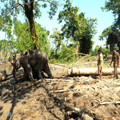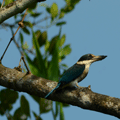
पर्यावरण एवं वन विभाग
अंडमान एवं निकोबार प्रशासन



The Andaman & Nicobar Islands have a Geographical area of 8249 sq. km, out of which an area of 7171 sq. km (87%) is notified as forest under Indian Forest Act, 1927 and this rich Eco-system support a variety of Flora and Fauna with in itself. Out of the total area 7171 sq km notified as forest 70% is totally protected in the form of Tribal Reserve, Biosphere Reserve, National Park and Sanctuaries and further in the form of mangrove conservation working circle and protection working circle even within the area covered by Working Plans.

1883-1974
First settlement was established in these islands in1857. Early settler cleared land for roads, building and for cultivation under the guidance of Royal Engineers, Public Works Department and Commissariat Department. Colonisation of these Islands was a deliberate policy of Govt. of India, not only with a view to resettle the refugees who were the victims of partition but also for strategic reasons. Under the colonization scheme the settlers were promised 5 acres of flat land for paddy cultivation, 5 acres of hilly land for plantation, cash crops and one acre as home stead land. The clearance of timber from the forest land was carried out for the settlement. The settler were allotted flat land for paddy, hilly land for raising crop, the timber for construction/repair of their houses, manufacture of agriculture implements & dinghy and Minor Forest Produce for their bonafide use on free of royalty. Though forests were cleared for settlement in 1858, the local timber wa considered useless and till 1870 Burma teak was imported for all buildings. Thereafter, Padauk and Silvergray commanded good market in London and New York. Increased demand for timber during the World War I brought into the market many lesser-known species. Andaman timber was in the international timber trade, as late as 1958, when a decision was taken to stop the export of timber. Steam tramway was introduced in 1903 from Shoal Bay to Port Blair. Construction of road to take out timber was started in 1914 in Bomlungta. The steam vessel, "Rosamund" was purchased in 1905 to initiated water transport followed by another steam vessel "Montagu-Douglas" in 1930.B.S. Chengappa introduced graded drag-paths, log-shoots and tramlines along the contour, avoiding costly culverts and bridges, using hollow padauk logs instead. Branches of trees were used as sleepers for dragging the timber using elephants. Chengappa also introduced the method of preparing rafts of floaters and semi-floaters and semi-floater logs and towing them using tug-boats.
Till 1870 there was no commercial exploitation of forest products. From 1870, Padauk gained commercial importance and it was exported to Indian market in the form of hand sawn squares and scantling. The local Administration considered it necessary to organize the forest department and it came into existence in 1883. Irregular and selective fellings were introduced and teak and padauk plantations were taken up. Mainly padauk was being extracted with some gurjan and a few other species. Forestry activities in Andaman were always exploitation oriented which were selective and irregular till 1906. In 1921 selection felling of marketable species over a girth limit was discontinued and clear felling system was introduced, however after 3 years the selection system was re-introduced. Irregular and selective felling remained confined to commercially important species. During the occupation of Japanese no attention was paid to the management techniques.

1947-1985
This was a period of intense forestry activity related to settlement and colonization. The "Andaman canopy lifting shelter wood system" was decided suitable and used for forestry operations. With the perfection of re-generation technique, the natural re-generation over extensive area was carried out against the pure plantation. This was for enhancing the value of the forest in the commercial terms, and commercial species were encouraged in tune with the then National Forest Policy of 1952. This resulted in a change of forest composition and diversity in favour of commercially important species.
In 1970s after realizing the true importance and potential of the island's biodiversity, Forest Department took initiative on wildlife protection and management on a scientific basis. The Wildlife Protection Central Rules were framed in 1973 and they came into force on 1st July 1973, as was required under the newly framed national Wildlife Protection Act in 1972.

1986 to Today
During this period there was a growing importance for forestry research and social forestry. In 1999 the State Forestry Research Plan was drawn with the support of Indian Counsel of Forestry Research and Education. 24 priority areas of forestry research were included in National Forestry Research Plan in 2000.
Consequent to the order of the Hon'ble Supreme Court, dated 07.05.2002 the revision of the working plans was carried out due to the reason that there is a major shift from past system of management.
With the intervention of the Supreme Court in the forest management of the Andaman & Nicobar Islands, all future timber extraction activities shall remain confined to 15% of the forest area which was worked and regenerated earlier. This will ensure that 85% of the forest area shall remain intact for conservation of biodiversity and protection of aboriginal tribes. The quantum of timber extraction has been drastically reduced and limited to 30,000 cum per annum solely for the purpose of meeting the local timber requirements. The export of timber from the islands has been discontinued. The system of providing NTFP free of royalty, which often leads to wasteful collection, has been discontinued. These measures are expected to reduce the pressure on the natural forests to a great extent.
The bio-diversity strategy and action plan was prepared in 2005.
Between 2000 and 2008, the Forest department initiated many collaborative projects with institutions of repute and also compiled information on various aspects related to Conservation and Development. The forest department along with the Department of Space did a collaborative work on biodiversity characterization at landscape level, using Remote Sensing data. This work completed in 2003, helped in identifying many new forest types (IIRS, 2003). The Forest department became the nodal department for the National (Natural) Resources Information System (NRIS) created by the Department of Space. The Andaman Nicobar Space Application Cell (AN-SAC) was established in the department to provide the required scientific input for various administrative and management decisions.
The Forestry practices in these islands have undergone remarkable changes in the last 132 years, influenced by major policy changes and socio-economic and political situations in this country and abroad. It has made the Department responsible for implementation of colonization schemes of Government of India followed by commercial forestry with emphasis shifted to industrial activity, the working during last 20-30 years illustrates Department's concern towards conservation of Biodiversity along with sustainable use of forest produce for local inhabitants. The present role is more inclined to protect the environment for future generation. The thrust areas of forest management have changed and scope is further enlarging due to new policies and legislations.